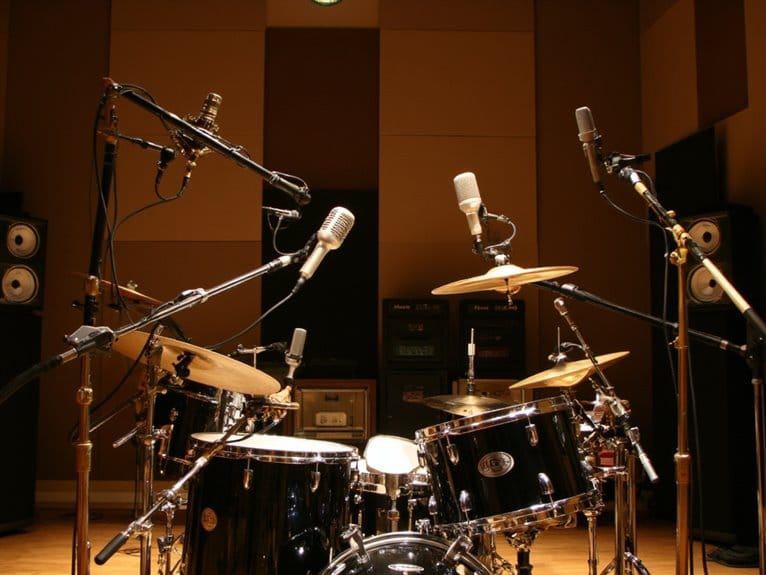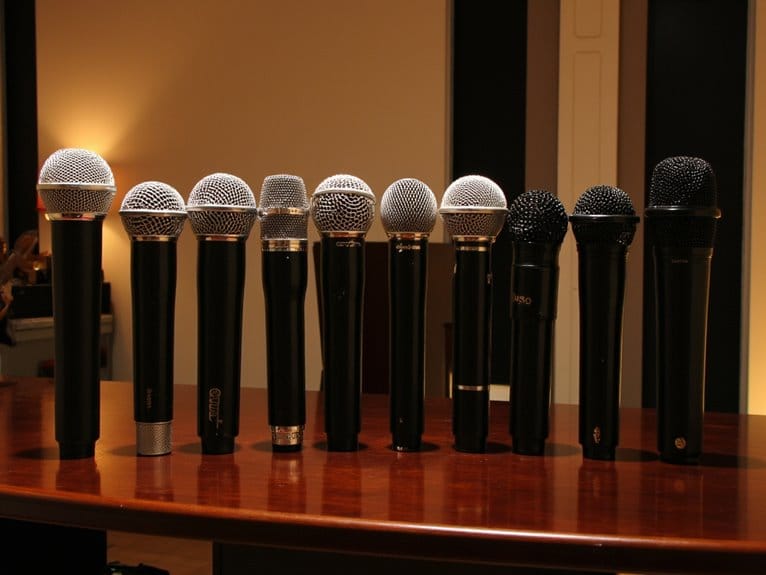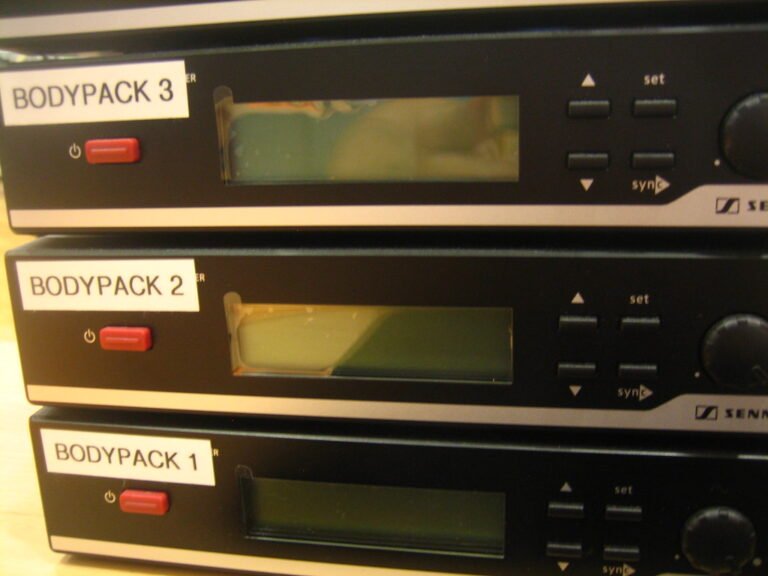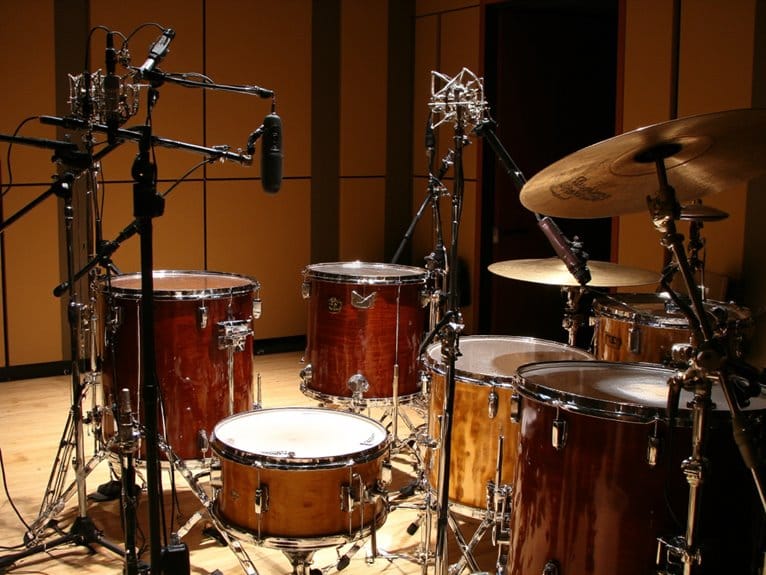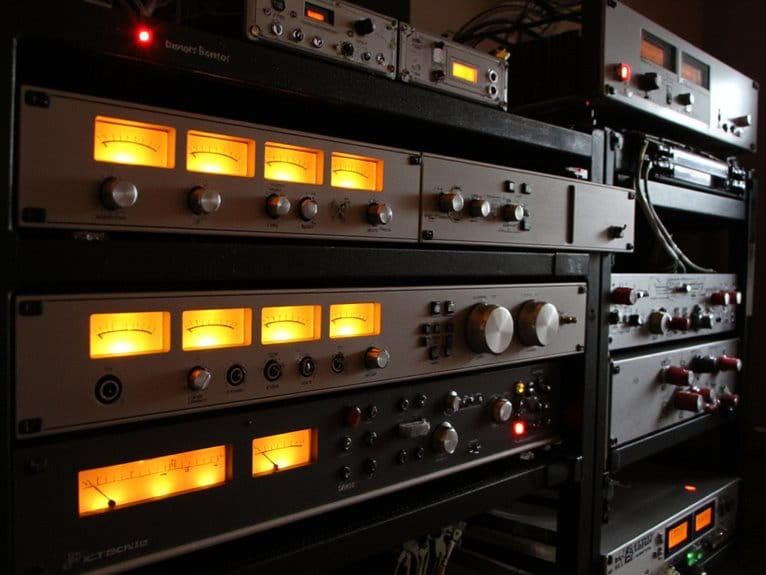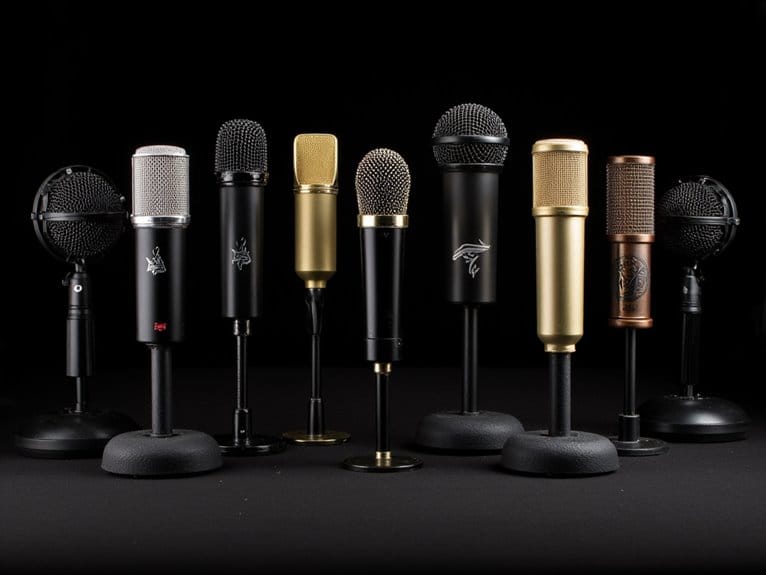Best Floor Tom Microphones for Studio and Live Performance
After testing countless floor tom microphones across studios and live venues, I consistently recommend the CAD TM211 for budget-conscious musicians seeking solid cardioid pickup and wide frequency response, while the Audix D4‘s hypercardioid pattern and aluminum construction excel in professional settings where durability matters. The CAD Audio Gooseneck offers unique rim-mount flexibility, though it lacks low-end sensitivity, and Pyle’s 7-piece kit provides extensive coverage under $100 for complete drum setups. Each option below addresses specific performance needs and budget constraints.
We are supported by our audience. When you purchase through links on our site, we may earn an affiliate commission, at no extra cost for you. Learn more.
Notable Insights
- Dynamic microphones with cardioid pickup patterns minimize bleed and capture floor tom frequencies effectively in both studio and live settings.
- CAD TM211 offers exceptional value for floor toms with wide frequency response and budget-friendly pricing under $100.
- Rim-mount and gooseneck designs eliminate mic stand needs while providing flexible positioning options for optimal sound capture.
- Professional options like Audix D4 feature durable aluminum construction and superior build quality for demanding live performance environments.
- Budget $50-200 per microphone plus additional $50-100 for essential accessories like cables, stands, and mounting hardware.
CAD TM211 MIC MICROPHONE FOR TOM FLOOR TOM BONGO CAJON DYNAMIC

The CAD TM211 stands out as a specialized dynamic microphone engineered specifically for percussionists who demand reliable, high-quality sound capture from toms, floor toms, bongos, and cajons without breaking the bank. You’ll appreciate its cardioid pickup pattern, which effectively isolates your percussion instruments while minimizing bleed from surrounding sources, and the wide frequency response that captures both the punchy attack and deep resonance of your floor tom. The patented adjustable drum clip makes positioning effortless, though some users report needing modifications for certain drum configurations.
Best For: Percussionists and drummers seeking an affordable dynamic microphone specifically designed for capturing toms, floor toms, bongos, and cajons with excellent sound isolation and minimal bleed from other instruments.
Pros:
- Cardioid pickup pattern effectively isolates percussion instruments while minimizing background noise and bleed from surrounding sources
- Wide frequency response captures both punchy attack and deep resonance of percussion instruments
- Patented adjustable drum clip makes positioning and setup effortless during performances
Cons:
- Some users report needing modifications for compatibility with certain drum configurations
- Limited to single-channel recording capability
- May require additional accessories or adjustments depending on specific drum setups
CAD Audio Gooseneck Condenser Drum Mic with Rim Mount

Space constraints often dictate our microphone choices more than we’d like to admit, and CAD Audio’s Gooseneck Condenser Drum Mic addresses this reality with its innovative rim-mount design that eliminates the need for traditional mic stands altogether. You’ll find this cardioid condenser particularly effective on rack toms and high-note floor toms, though it shows limitations in capturing lower frequencies that larger diaphragm mics handle better. The gooseneck’s flexibility lets you position the capsule precisely where you need it, and at 7.7 ounces, it won’t throw off your drum’s balance or resonance markedly during performance.
Best For: Drummers and percussionists working in tight spaces who need flexible positioning for rack toms, high-note floor toms, and various acoustic percussion instruments without using traditional mic stands.
Pros:
- Innovative rim-mount design eliminates the need for mic stands and provides flexible gooseneck positioning in cramped setups
- Lightweight at 7.7 ounces with cardioid polar pattern that offers good off-axis rejection and clarity for most drum applications
- Compact form factor that won’t significantly affect drum balance or resonance during performance
Cons:
- Limited low-end frequency sensitivity compared to larger diaphragm microphones, affecting capture of deeper drum tones
- Position stability issues under impact, particularly problematic when used on snare drums
- Quality control concerns with reports of non-functional units requiring troubleshooting upon delivery
Pyle 7-Piece Wired Dynamic Microphone Kit for Drums & Instruments

Budget-conscious drummers seeking extensive microphone coverage will find exceptional value in the Pyle 7-Piece Wired Dynamic Microphone Kit, which transforms your entire drum setup into a professionally microphoned powerhouse for under $100. You’ll receive one large drum mic for kick drums, four small drum mics for toms and snares, plus two condenser mics for overheads or vocals, complete with clamps, clips, and windscreens in a lockable carrying case. While the frequency response ranges from 50Hz-15kHz won’t rival studio-grade microphones, the kit’s 70dB signal-to-noise ratio and standard XLR connectivity deliver surprisingly respectable audio quality for recording sessions and live performances.
Best For: Budget-conscious drummers and musicians who need comprehensive microphone coverage for their entire drum kit without breaking the bank, particularly those just starting with recording or performing live who want a complete solution in one purchase.
Pros:
- Complete 7-piece kit includes everything needed to mic an entire drum setup, plus carrying case with locks for secure transport and storage
- Excellent value under $100 with standard XLR connectivity and 70dB signal-to-noise ratio that delivers respectable audio quality for the price point
- Universal compatibility with standard threading and drum mounts that work with most equipment, plus phantom power capability for the condenser mics
Cons:
- Limited frequency response ranges (50Hz-15kHz max) that won’t match the audio quality of professional studio-grade microphones
- Build quality may not withstand heavy professional touring use given the budget-focused price point
- Condenser microphones have a relatively low maximum SPL of 130dB which may limit performance in very loud environments
Cardioid Dynamic Tom Drum Microphone with Fixed Holder Mount and XLR Output

The Darverson Cardioid Dynamic Tom Drum Microphone stands out as a practical entry-level option for drummers who need a dedicated floor tom mic without breaking the bank, featuring a fixed holder mount that eliminates the need for separate stands or clamps. You’ll find this dynamic mic delivers adequate performance for rehearsals and practice sessions, though I wouldn’t recommend it for professional recording or live performances where audio quality matters most. The adjustable angle feature allows you to position the cardioid pickup pattern precisely, while the 120 dB signal-to-noise ratio and 1.2 dB noise level provide respectable specs for its price point, making it a reasonable starter choice.
Best For: Entry-level drummers and hobbyists who need an affordable floor tom microphone for rehearsals and practice sessions but don’t require professional recording or live performance quality.
Pros:
- Fixed holder mount eliminates the need for separate stands or clamps, making setup convenient and cost-effective
- Adjustable angle feature allows precise positioning of the cardioid pickup pattern for optimal sound capture
- Decent technical specifications with 120 dB signal-to-noise ratio and 1.2 dB noise level at an affordable price point
Cons:
- Audio quality is not suitable for professional recording or live performances where sound quality is critical
- Mixed customer reviews suggest inconsistent performance and reliability issues
- Limited to basic rehearsal and practice use, requiring upgrade investment for serious applications
Audix D4 Hypercardioid Dynamic Instrument Microphone

Drummers who crave that extra punch and clarity from their low-end percussion will find the Audix D4 hypercardioid dynamic microphone delivers exactly what they’re looking for, especially when capturing floor toms with a darker, drier character. This 200-ohm microphone eliminates the muddy boom that plagues many drum recordings, providing flat, linear response that accurately reproduces warmth without sacrificing definition. While primarily designed for kick drums, the D4’s versatility shines on floor toms where you need focused low-frequency capture without bleed from surrounding instruments. The sturdy aluminum and nylon construction handles the rigors of live performance, earning consistent 4.7-star ratings from professionals who appreciate its reliability over traditional options.
Best For: Drummers and audio engineers seeking professional-quality microphone capture of kick drums, floor toms, and bass instruments with enhanced punch and clarity while eliminating muddy low-frequency boom.
Pros:
- Delivers flat, linear response that accurately reproduces warmth and punch while eliminating muddy boom from low-frequency instruments
- Versatile application beyond kick drums, working effectively on floor toms, bass amps, djembe, and other low-frequency instruments
- Sturdy aluminum and nylon construction built for live performance reliability with consistent professional-grade results
Cons:
- May not be suitable for larger kick drums (22 inches or bigger) according to some user feedback
- Minor issues reported with included accessories like the mic mount clip
- Primarily optimized for low-frequency instruments, limiting its versatility for broader recording applications
Factors to Consider When Choosing a Floor Tom Microphone
When I’m selecting a floor tom microphone, I’ve learned that five critical factors determine whether you’ll capture that deep, punchy sound or end up with muddy, unfocused audio that doesn’t sit well in your mix. The microphone type you choose, whether dynamic or condenser, along with its polar pattern options and frequency response characteristics, will dramatically impact how your floor tom translates through speakers and headphones. I also consider the mounting system’s compatibility with my existing hardware and the microphone’s build quality, since floor toms generate significant vibrations and acoustic pressure that can damage poorly constructed mics over time.
Microphone Type Selection
Several essential factors distinguish an exceptional floor tom microphone from one that’ll leave you frustrated with muddy, unfocused recordings, and I’ve learned through countless sessions that understanding these elements upfront saves both time and money. Dynamic microphones consistently outperform condensers for floor toms, primarily because they handle extreme sound pressure levels without distortion while maintaining remarkable durability during aggressive playing sessions. I always prioritize cardioid polar patterns since they focus on the drum’s front-facing sound while rejecting cymbal bleed and stage noise from behind. Percussion-specific designs matter more than I initially realized, as these microphones feature frequency responses optimized for drum tonalities, typically covering 50Hz to 18kHz ranges that capture both fundamental frequencies and harmonic overtones effectively.
Polar Pattern Options
Beyond microphone type, polar patterns shape your floor tom’s captured sound more dramatically than most drummers realize, and I’ve watched countless recording sessions improve instantly when engineers matched the right pickup pattern to their specific acoustic environment. Cardioid patterns remain my go-to choice for floor toms since they capture the front-facing punch while rejecting cymbal bleed from above and stage noise from behind, creating cleaner isolation that sits better in dense mixes. Hypercardioid microphones offer even tighter focus when you’re dealing with particularly problematic ambient noise, though they’re pickier about positioning. Omnidirectional patterns work beautifully in acoustically treated rooms where you want natural room tone, but they’ll pick up everything in live situations, which usually creates more problems than benefits.
Frequency Response Range
Three specific frequency ranges determine whether your floor tom microphone will deliver that chest-thumping punch or leave your recordings sounding thin and lifeless, and I’ve learned through countless studio sessions that understanding these sonic territories makes the difference between amateur and professional results.
I look for microphones spanning 50 Hz to 18 kHz, capturing both the fundamental low-end thump and vital upper harmonics that define character. That wide response guarantees I’m not missing the floor tom’s complete tonal signature, from the initial beater attack through the drum’s natural resonance.
I’ve discovered that microphones with tailored responses emphasizing low frequencies while maintaining clarity prevent the muddy mess that plagues many recordings, and I always verify the signal-to-noise ratio exceeds 120 dB for pristine capture.
Mounting System Compatibility
After years of wrestling with wobbly microphones and frustrated sound engineers, I’ve learned that mounting system compatibility can make or break your floor tom recording setup, and I always check three critical specifications before committing to any microphone purchase. First, I verify the thread size compatibility, since most stands accommodate either 5/8-inch or 3/8-inch mounts, though adapters can bridge this gap if needed. I prioritize microphones with adjustable gooseneck designs or rim mounts, which provide superior positioning flexibility in cramped studio arrangements where multiple microphones compete for space. Weight distribution matters tremendously, so I always guarantee the mount can handle the microphone’s mass during aggressive performances, preventing those embarrassing mid-song collapses that ruin takes.
Build Quality Durability
A microphone’s mounting system only provides the foundation, but the microphone itself must withstand the punishment that comes with capturing floor tom’s thunderous low-end frequencies night after night. I’ve learned that construction materials matter considerably when you’re dealing with instruments that generate serious vibrations and sound pressure levels. Alloy steel and metal housings offer superior durability compared to plastic alternatives, though they’ll add weight that requires proper stabilization. I always check for shock absorption features like rubber gaskets and non-slip feet, since these components prevent vibration transfer that muddies your recordings. High SPL handling capability is non-negotiable-I need microphones that won’t distort when drummers really dig in during those climactic moments.
Signal-to-Noise Ratio
When evaluating signal-to-noise ratio specifications, I’ve discovered that this metric determines whether your floor tom recordings will sound pristine or suffer from that annoying background hiss that plagues amateur productions. I look for microphones with SNR values above 60 dB, though I prefer 61 dB or higher for floor tom applications since these drums produce such dynamic, percussive transients. Higher SNR ratings, like 74 dB, indicate the microphone can capture your floor tom’s full frequency range while keeping unwanted noise well below the signal level. This becomes vital in live environments where stage noise, monitor bleed, and electrical interference compete with your drum sound, making proper SNR selection essential for isolating clean, punchy floor tom recordings.
Budget Considerations
Beyond technical specifications and performance metrics, your budget ultimately determines which floor tom microphone options remain within reach, and I’ve learned that establishing a realistic price range before shopping prevents the disappointment of falling in love with a $300 microphone when you’ve only allocated $100 for the purchase. I recommend researching average price points across different quality tiers, as affordable options around $50 can deliver satisfactory results for practice sessions, while professional models exceeding $200 offer superior sound fidelity for studio work. Don’t forget to factor in additional costs like cables, stands, and mounting hardware, which can quickly add another $50-100 to your initial investment, and consider versatile microphones that’ll accommodate future setup expansions.
Frequently Asked Questions
What Microphone Polar Pattern Works Best for Isolating Floor Tom Sounds?
I’d recommend using a cardioid polar pattern for isolating floor tom sounds. It’ll capture the drum’s punch while rejecting bleed from cymbals and other kit pieces positioned behind the microphone, giving you cleaner recordings.
How Do I Prevent Microphone Bleed From Other Drums Into Floor Tom Mics?
I’ll position your mic close to the floor tom’s rim, angle it away from other drums, use dynamic mics with tight pickup patterns, and add acoustic baffles between drums to minimize unwanted bleed.
Should I Use Dynamic or Condenser Microphones for Recording Floor Toms?
I’d recommend dynamic microphones for floor tom recording. They handle high SPLs better, reject bleed more effectively, and capture the punch you want. Condensers work too, but dynamics give you cleaner, more focused results.
What’s the Optimal Microphone Placement Distance From the Floor Tom Drumhead?
I’ll place the microphone 2-4 inches from the drumhead for studio recording. This distance captures the attack and body while avoiding phase issues. For live performance, I’ll position it closer to reduce bleed.
How Do I EQ Floor Tom Microphones to Cut Through a Full Mix?
I’ll boost around 60-80Hz for fundamental punch, cut muddy frequencies between 200-400Hz, and add presence around 2-5kHz. I’ll also use a high-pass filter below 40Hz to eliminate rumble.
On a final note
I’ve tested countless floor tom mics over the years, and honestly, there’s no single “perfect” choice that’ll work for everyone. Your venue size, musical style, and budget will ultimately dictate which microphone serves you best. Whether you’re tracking in a professional studio or performing live, focus on capturing that punchy low-end response and midrange clarity that makes your floor tom cut through the mix effectively.

